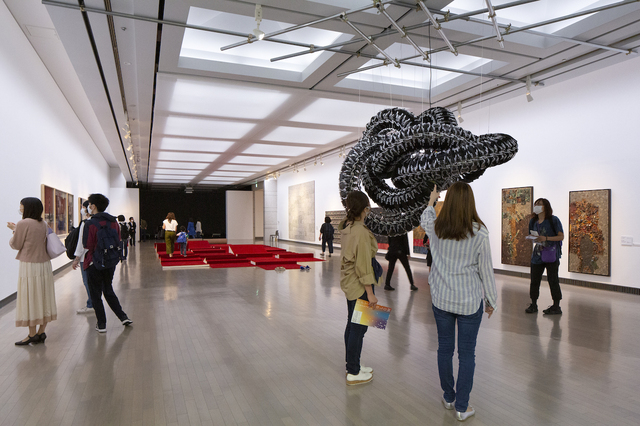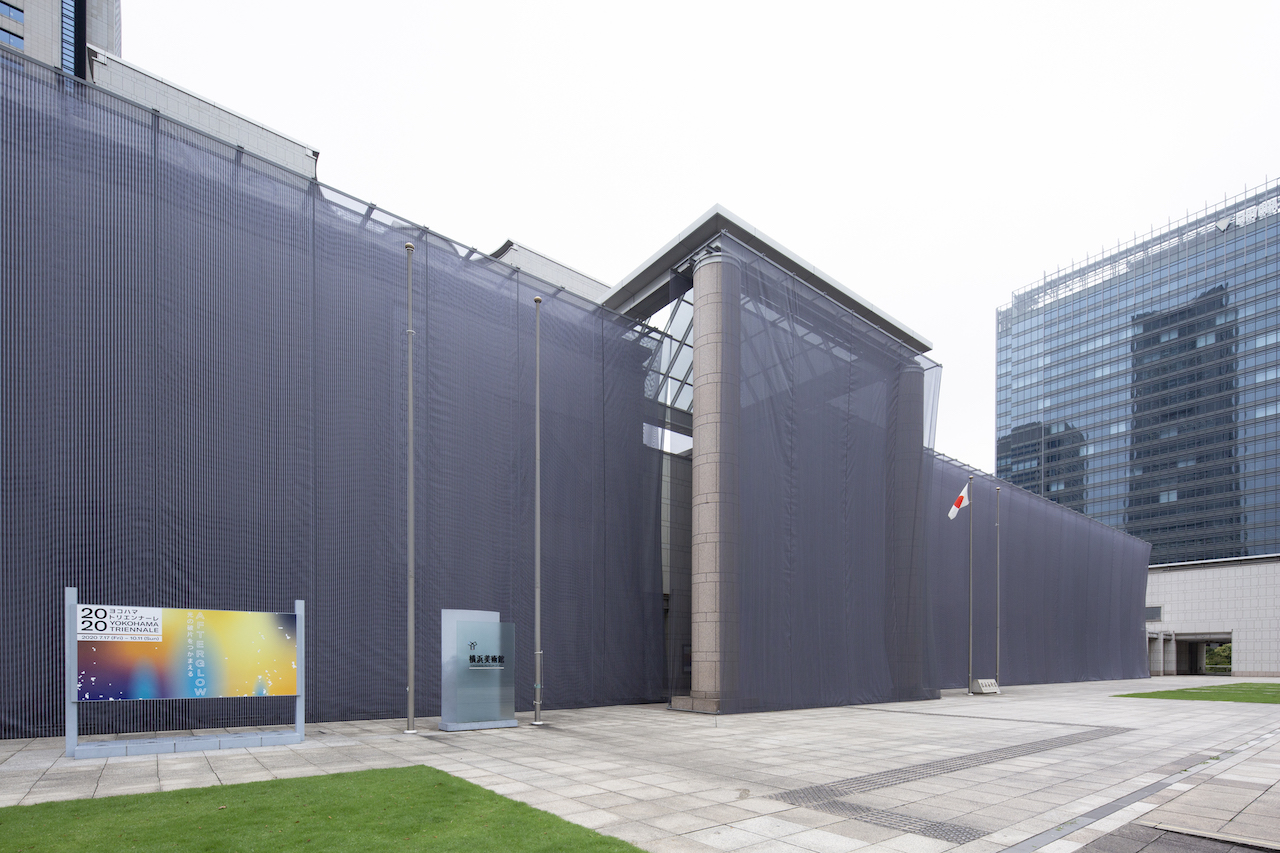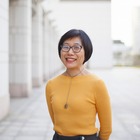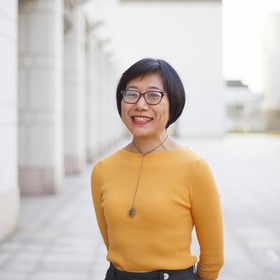Yokohama Triennale 2020

Photo:Otsuka Keita
Photo courtesy:Organizing Committee for Yokohama Triennale
The Presage
On February 3rd, 2020, the Diamond Princess cruise ship arrives at Daikoku Pier in Yokohama Port. A medical examination confirms that a passenger is infected with the novel coronavirus. The ship undergoes a quarantine for 14 days from February 5th. On March 1st, all 3,711 passengers and the crew disembark the ship.
Two months earlier, at the end of November 2019, Yokohama Triennale 2020 quietly unfolded to mark its beginning of the “Episōdo,” or a series of programs proposed by Raqs Media Collective (Raqs), the artistic director of Yokohama Triennale 2020. Raqs had an idea not to confine the Triennale to the duration and the physical site of the exhibition, but to expand it beyond the conventional exhibition model in temporal and spatial terms through the “Episōdo.” It was during “Episōdo 00,” the first of the series held in November, that Raqs introduced this concept. It was also during this program that the artist Yuichiro Tamura revealed that the Port of Yokohama was where the plague first landed in Japan at the late 19th century in his performance work, Awe / If.
Raqs also shared the Sourcebook, or a compilation of five texts collectively called the “source,” and the key terms, “autodidact,” “luminosity,” “friendship,” “care,” and “toxicity,” as the basis for discussions with artists and the public. In the Sourcebook, they described the relationship between luminosity and toxicity as follows:
Corals glow to counter the poison of ultraviolet radiation, and crystalline jellyfish are harvested for ‘reporter genes’ to help detect toxicity: There is a connection between the luminous and the toxic.
At the time “toxicity,” or contamination, waste, and elimination, to which Raqs took great interest, was still an ambiguous term to many of us. However, by the time the cherry blossoms were in bloom, it became a focus of our attention with the coronavirus crisis sweeping across Japan and the world.
Timeline Leading Up to the Opening of Yokohama Triennale 2020
The timeline leading up to the opening of the Yokohama Triennale 2020 (YT2020) is as follows:
| 2019 | |
|---|---|
|
November 30 |
YT2020 “Episōdo 00 Sharing our Sources” |
| 2020 | |
|
January 16 |
Ministry of Health, Labor and Welfare announces that a man living in Kanagawa Prefecture is confirmed as having the novel coronavirus |
|
January 17 |
Meeting with Raqs in Japan to discuss the details of the YT2020 exhibition plan |
|
January 29 |
YT2020 participating artist, in Yokohama for research since December, returns to his home country |
|
February 9 |
YT2020 participating artists in Yokohama for research |
|
February 11 |
The World Health Organization (WHO) formally names the novel coronavirus disease COVID-19 |
|
February 15 |
Yokohama Museum of Art “Concave and Convex: A Sumikawa Kiichi Retrospective” exhibition opens |
|
February 29 |
Yokohama Museum of Art temporarily closes |
|
March 11 |
WHO declares the spreading novel coronavirus outbreak a pandemic |
|
March 24 |
Prime Minister Abe and IOC President Bach agree to delay the Tokyo Olympics by one year |
|
March 13 |
Amendment is made to the Act on Special Measures for Pandemic Influenza and New Infectious Diseases Preparedness and Response |
|
March 30 |
Tokyo 2020 Olympic Games’ new date (July 23 to August 8, 2021) is announced. |
|
April 7 |
Prime Minister Abe declares a state of emergency in Tokyo, Kanagawa, and five other prefectures |
|
April 16 |
State of emergency is declared nationwide |
|
May 1 |
Yokohama Museum of Art closes its exhibition (earlier than its original end date May 24) |
|
May 14 |
State of emergency is lifted for 39 prefectures |
|
May 25 |
State of emergency is lifted for Tokyo and Kanagawa |
|
June 3 |
Change of YT2020 opening date from July 3 to July 17 is announced |
|
June 19 |
Voluntary travel restrictions are lifted across all prefectures |
|
June 23 |
Online ticket sales for YT2020 start |
|
July 3 |
“Episōdo X,” a digital platform, opens |
|
July 16 |
YT2020 press preview |
|
July 17 |
YT2020 opens to the public |
At the end of March 2020, when the novel coronavirus was spreading, the Triennale was reaching its first critical milestone; details of fabrication, transportation, and artists’ travel had to be finalized and put on competitive tender. The press announcement was to be made in April, and fabrication and installation were to start in May.
As the Tokyo Olympics 2020 was on our calendar, we were ready to face challenges in securing resources, accommodation, and transportation, as well as controlling the budget with the rising cost. But with the outbreak of a pandemic taking over the Olympics, we had to prepare ourselves to a new set of challenges.

Ivana Franke
Resonance of the Unforeseen 2020
© Ivana Franke
Yokohama Triennale 2020 installation view
Photo:Keita Otsuka
Photo courtesy:Organizing Committee for Yokohama Triennale
Making the Decision
Amid the global pandemic, Yokohama Triennale 2020 opened on July 17th, two weeks later than previously planned, with all the necessary preventive measures in place. In making the decision to delay the opening, we went through a list of various factors without knowing whether or not fabrication will proceed as planned and work from overseas would arrive on time. We also had to factor in new schemes, such as controlling visitor numbers, adding resources to prevent infection, and making changes to the docent operation. As a result, we were forced to navigate through untested waters.
We have been often asked whether or not we ever considered postponing or canceling the event altogether. We really did not have any other choice, is our answer.
First of all, postponement was not possible because Yokohama Museum of Art was due to close from spring 2021 for large-scale renovations. Furthermore, we had already finalized the floor plan of the artworks, therefore, reconfiguring the plan for a new venue did not look feasible.
“Why did you not cancel it, then?” some would ask.
The Triennale is the largest art project in the City that takes place over a duration of three months. Since the Diamond Princess arrived at the port in February, we witnessed the situation of the novel coronavirus change everyday. So, by the time we started our discussions in March, we knew that it was impossible to predict what was to happen in the following months. What if the situation could turn around in the summer? If we cancel now, we will miss the opportunity to open when the situation improves.
Of course, we were aware that preparing for the exhibition amid an outbreak posed a considerable risk for those of us working on-site, and that postponing or canceling would be the logical step. However, we could not simply waste all our efforts that we had put into the project. Thus, it made more sense to discuss the possibility of altering the format than to canceling the event.
In making this decision, our experience in opening the fourth edition in 2011 crossed our minds. The preparation for the 4th edition in 2011 was behind schedule from its start. I only arrived in Yokohama in September 2010, and we had only ten months leading to the opening, despite the fact that it was the first time the Yokohama Museum of Art was hosting this large-scale event. We were racing with time when the Great East Japan Earthquake struck on March 11. In fact, we were in Tokyo waiting for our mayor to arrive for the press conference from 3 o’clock when the building shook. In the aftermath of the earthquake, we discussed whether or not opening the Triennale was feasible while complying to the energy-conserving scheme that was enforced by the government as a result of the nuclear powerplant disaster. At the time, the consequences of the radiation contamination were uncertain, and we had no idea whether we would be able to borrow artworks from overseas or whether the artists would be able to come to Japan, so we had to deal with the problems, one at a time. Fortunately, Eriko Osaka, who was the director of the Yokohama Museum of Art, Akiko Miki, who was the artistic director, and most notably, Mayor Fumiko Hayashi of Yokohama City, all agreed to open the exhibition as initially planned, and gave us authorization to move forward. When the Triennale opened in August, we saw a large number of visitors from all walks of life queuing up at the entrance, and the final turnout was comparable to that of our very successful first edition in 2001. We saw people admiring the works, taking pictures, and chatting with each other while looking at art. They were all eager to see art after many weeks of enduring sadness and despair. It was an experience that made us realize how art is essential in our society and vital to our everyday life.
For this edition, we believed that Raqs’ concept and their selection of artists and artworks, would provide insight into the various issues we were facing under the pandemic. They were “like canaries in the coal mine,” as described by Mika Kuraya, the director of the Yokohama Museum of Art. This was the right moment to present the Triennale to the public. Although it was most likely that they would not be able to see the Triennale in person, Raqs agreed with us and expressed a strong desire to make this Triennale a reality.
Incidentally, as we proceeded with the preparations, we realized that the Triennale was also crucial for sustaining the artists’ activities. Many of the world’s biennales and triennales scheduled for 2020 were postponed: some, like the Venice Biennale, was postponed for one year, while others, like the Berlin Biennale and the Gwangju Biennale, were postponed by several months. Many artists were stuck in a state of uncertainty as exhibitions were canceled one after another, leaving their works in progress in limbo with nowhere to go. It was important for us to support the artists and make their artworks essential by presenting their works in a physical exhibition.
Operation Amidst the Coronavirus Crisis
The Yokohama Triennale 2020 opened to the public with all of its content intact and all the measures to prevent the spread of the novel coronavirus in place. Needless to say, the day-to-day operation was complicated than usual and required more resources than originally planned.
The Exhibition
Our preparation was disrupted from time to time: many companies were working from home; acrylic sheets fell short of supply due to medical demand; and schedule for transporting artworks were constantly changing.
We eventually learned that the cargo and FedEx were operating, albeit with congestion, reduced flights, and diverged routes. Needless to say, our staff in charge of logistics was busy corresponding with shipping companies and artists on a daily basis from morning to night.
In the meantime, many artists were confined to strict lockdowns in their countries/regions, and could not procure necessary supplies or proceed with their film productions as planned.
Since all the overseas artists were unable to come to Japan to install their works, the curatorial team had to work out the time differences and communicate with artists online on the details of the installation and obtain artists’ approval. As the space experienced through a mobile screen could not substitute that of a real-life experience, the curatorial team had to endure a great deal of pressure in order to meet the artists’ expectations.
Furthermore, those artists who had planned to hold workshops in person were forced to either change their plans entirely or switch to using an online platform in a short period of time.
Operation
Ticket sales for the exhibition were all moved to an online platform with a pre-booking requirement. As museum-goers are usually accustomed to buying tickets at the ticket booth, advance reservations presented a hurdle. However, online ticketing was crucial to controlling admission and enforcing social-distancing. We had to abide by the museum guidelines that set a number of visitors allowed per space per time-slot.
We had cleaners go through the gallery spaces more frequently than usual and made extra efforts for disinfection, placing sanitizers in various corners of the venues. We prepared disposable masks and covers for headsets and other devices, and enforced disinfection before and after their use.
Major Changes
Finally, we were forced to make major changes to our visitor experience. We revised our target visitor 50 percent downwards from the initial target of 250,000 visitors. We also restricted visitors to a one-day admission, instead of the usual one admission per venue, allowing admission on different dates. The number of school visits was curbed and the activities of volunteer supporters were restricted, although efforts were made to shift some activities to online platforms.
Is Art Essential or Non-Essential?
The Triennale always brings new challenges. Things do not proceed as planned, and unexpected incidents are bound to happen. For this edition in 2020, we were warned that the resources will fall short due to the Olympics, and advertisement slots and accommodations would be fully booked. We were also warned that there will be a drop in visitor numbers while the games took place. We listened to these warnings and prepared ourselves to deal with these issues. However, it never occurred to us that the spread of the novel coronavirus would turn into a global issue and impact all of us regardless of where we live.
Running the Triennale through the pandemic proved that art is essential to our society. We saw that the usual performance indicators, such as visitor numbers and the economic impact figures, are less important, and that it is the artists and their visions that help us make sense of the world and survive the testing time.
(September 7, 2020)


